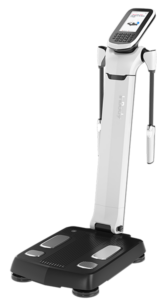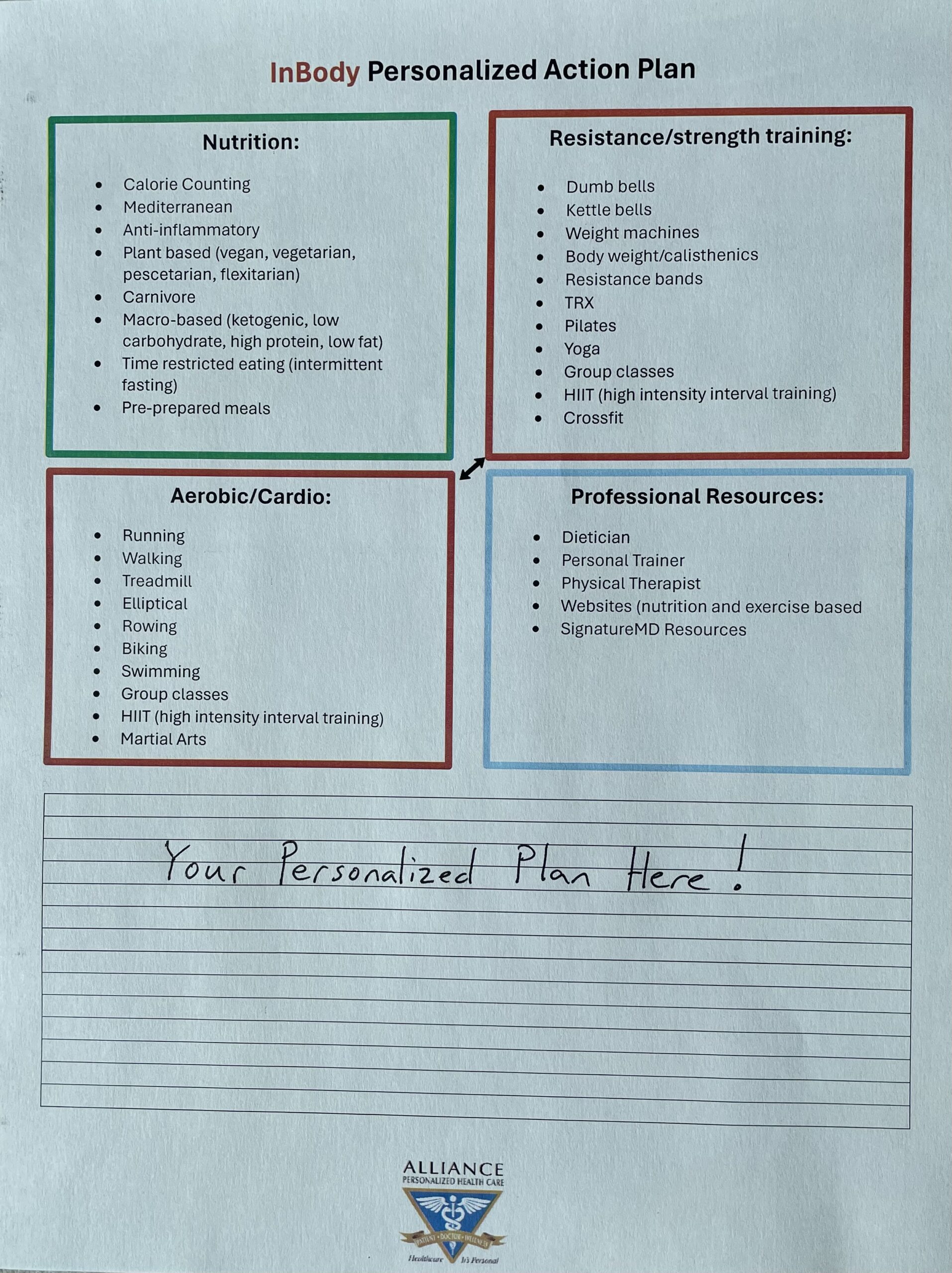It’s Called “InBody” – It’s Another Tool to Unlock Better Wellness
We would like to discuss body composition analysis, dietary choices, exercise regimens, and the integration of that into the Personalized Health Care Plan.

Bringing together elements that optimize your health:
Modern Technology
Your Story
Our Experience

Let’s get started…
Body Composition
At Alliance, we believe in looking at the whole person when we evaluate any part of health, and this includes body composition. We all know that weight can affect our health, and for years, people have heard the medical community telling them to eat healthy, exercise more, and lose weight (for most people). The BMI (body mass index) has been used as a way to measure this, but we have known for a long time that does not tell the whole story as the BMI just takes into account a person’s height and weight, which is then put into a formula to give a number It does not look at muscle mass or body fat. This means that a person who is a body builder, for example, would be classified as obese based on the BMI, while someone who is considered normal or underweight, may actually have too much fat, which is detrimental to their health.

A healthy body composition can decrease risk for many metabolic conditions such as high blood pressure, diabetes, cardiovascular disease, and contributes to a stronger immune system. As you can see in the picture above, someone of the same height and weight can have very different body fat percentages, which would give them a very different risk profile, although if you just look at weight and height, this would not be apparent.
Measuring body composition gives a more accurate idea of what is going on inside the body. There are multiple ways of measuring body composition including skin calipers, hydrostatic weighing, air displacement plethysmography, dexa scan, MRI, and bioelectric impedance analysis (BIA). We use BIA, as the other methods are more expensive, time consuming or not as accurate (in the case of skin calipers). BIA applies low-level alternating electrical currents to an individual to measure the volume of water through impedance values. The device measures how the electrical signal is impeded through different types of tissue. Muscle has high conductivity while fat does not. BIA provides estimates of body water based on the conduction rates, and then body fat is calculated via equations done by the machine.
A healthy body composition is different for men and women, mostly as women need a higher amount of fat for their bodies to function optimally. Essential fat, as the name implies, is essential for normal body functions, which includes insulation, protecting internal organs, storing vitamins, regulating hormones and childbearing.
.
Male
45% Muscle tissue
3% Essential fat
12% Non-essential fat
15% Bone
25% Other

Female
36% Muscle tissue
12% Essential fat
15% Non-essential fat
12% Bone
25% Other
These numbers are not exact, and there is generally a range of acceptable normal values. Age also plays a part in ideal body composition, with slight increases in body fat being normal as we age (the increase in body fat can be somewhat protective during acute illness). For example, total body fat (essential plus non-essential) ranges for males aged 20-39 are 8%-19%, while females are 21-32%, but when they are aged 40-59, males should be 11-21% and females 23-33%, and with ages 60-79, males should have 13-24% and females 24-35%.

Our testing measures various aspects of body composition, as seen on the report above, including:
Body fat percentage (PBF): this tells how much fat mass makes up your total body weight.
Skeletal Muscle Mass (SMM) (also shown as segmental lean mass): this shows how much skeletal muscle mass you have in each body segment (left, right, upper body, lower body and trunk), allowing you to focus on building more muscle or correcting imbalances to ensure you have a healthy muscle mass balance. Skeletal muscle is essential for mobility, posture and assists in metabolism.

Total Body Water (TBW): this includes both extracellular water (ECW, water outside the cells) and intracellular water (ICW, water inside the cells). A healthy balance is needed, and if it’s not balanced, this may need to be addressed.

Visceral fat: this is the fat that surrounds the organs, and while it is necessary to have some to protect the organs, too much can lead to significant health problems. Visceral fat can increase inflammation, which can lead to hypertension and has been linked to higher rates of heart disease, dementia, high cholesterol, cancers and insulin resistance. Studies have linked visceral fat to a three times higher risk for developing dementia.
The goal is to have this level less than 10, which is based on a proprietary formula from InBody.

Basal Metabolic Rate (BMR): this is the number of calories that your body needs to just exist (lying on the couch, not doing anything). This is a very useful number to know, as if you eat too few calories, you are likely to break down muscle tissue and worsen your body composition. We can use this number along with your specific goals to determine how many calories per day you need to achieve your goals.

How to improve body composition
Once you know your numbers, you can decide whether you want to make changes, and if you do, what you want to change. For example, if you want to add muscle mass, then having a higher caloric consumption is necessary, while if your goal is fat loss, then you would require less calories. The types of macronutrients is also important, especially protein, as it is important for both muscle growth and fat loss. Exercise is also essential for everyone, and the type of exercise you choose to do can affect your body composition.
Following the generation of the report, we will sit down to discuss details and together generate an action plan that may involve dietary changes, cardio training, muscle building, or recruitment of additional professionals. That report will look something like this:

Improving your body composition through diet and exercise:
Nutrition:
There is not one right way to eat. There is a myriad of dietary patterns. One size does not fit all. There are many factors that contribute to what and how you eat, including work, family, lifestyle, budget and preferences. What and how you eat can definitely affect your health. Certain ways of eating put you more at risk for certain conditions, and if so, it is important to get certain labs checked to ensure that you are not deficient in any area. Although we have listed a few dietary choices below, there are other dietary styles that people either choose to follow or are instructed to follow due to medical reasons (such as low FODMAP, gluten free etc).
Dietary Choices:
Mediterranean: The Mediterranean diet has been shown to reduce cardiovascular disease and is more of a way of living as well as a way of eating. There is no one definition of this, but it tends to be high in vegetables, fruits, whole grains, beans, nuts, seeds, olive oil, seasoning with herbs and spices. Fish and poultry are eaten in moderation along with beans, legumes and eggs as sources of protein. Moderate portions of dairy products are included, but red meat and foods with added sugar are limited. They also recommend that meals are shared with family and friends, drink moderate amounts of wine if you drink alcohol, and exercise regularly.
Vegetarian/plant based: All vegetarians exclude meat products, but there are many variations of vegetarianism beyond this. It is possible to eat a very healthy diet as a vegetarian, especially if it is plant based, or it can be not so healthy and filled with highly processed foods. Variations of being vegetarian include Vegan (strictly no animal products at all, including wearing animal products or using animal products around the home); Lacto-ovo (containing milk and eggs); Pescetarian (including fish and seafood); Flexitarian (allows occasional meat or seafood)
Calorie Counting: This is exactly how it sounds. Setting a calorie goal and trying to meet it. This may or may not also look at the types of foods that are eaten. We do not endorse following a very low calorie diet for most people, as this tends to mess up your metabolism longer term. Some examples of this include weight watchers (who use points as a surrogate for calories) and many apps which help you to track your calories.
Time restricted eating (AKA intermittent fasting): Time restricted eating involves only eating at certain times of the day. Many people choose to restrict their eating to 6 or 8 hours, and fast the rest of the day. For some, that can be as simple as skipping breakfast, or finishing eating after lunch. This type of eating can be combined with many of the other eating strategies mentioned here.
Paleolithic: this way of eating emphasizes whole and unprocessed foods.
Macro based: These diets focus on the ratios of protein, carbohydrates and fats. The following four diets all fall within this category:
Ketogenic: This focuses on a high fat, moderate protein and very low carbohydrate (often below 20gms per day) in order to allow your body to get into ketosis
Low carbohydrate: similar to a ketogenic diet, but generally not as low a carbohydrate level as ketogenic. Tends not to be high fat.
Low fat: The focus is on keeping fat levels low.
Carnivore: A carnviore diet refers to the consumption of animal-based foods. People who follow a carnivorous dietary pattern eat almost exclusively only meat and other animal-based foods. This would include meat, fish, eggs, low lactose dairy, and may include honey, salt, pepper and zero carb seasonings. It generally excludes fruits, vegetables, grains, high lactose dairy, sugars and plant based oils.
We can provide more information on any of these or other dietary plans, as well as refer you to a dietician.
Using the InBody to measure your body composition and determine your BMR helps you to decide how many calories per day you need to change your body composition. Naturally, the types of food you eat will affect how your body composition changes, and remember that protein helps to build muscle and too little protein will lead to muscle loss.

And there are so many more dietary options, but we have to stop somewhere.
With regards to exercise, there are just as many options, but let’s discuss some aspects of the purpose.

Exercise:
Exercise is always recommended to be part of a healthy lifestyle. The current physical activity guidelines for Americans recommends that all adults (including those who have chronic illnesses or disabilities) get at least 150 minutes of moderate exercise per week, which can translate into 75 minutes of vigorous activity per week, or a combination of moderate and vigorous exercise. In addition, adults should also do 2 days per week of exercise that strengthens muscles. There are many options, but the biggest recommendation is to find an activity that you enjoy (or hate the least), and just do it. Scheduling physical activity like it is an appointment or meeting can help some people to ensure it is done and allows you to dedicate time for exercise. Finding a time which works well in your day (eg early morning before the rest of the household wakes, immediately after work before you go home). Simple strategies such as parking further away from your destination or taking stairs rather than an elevator allow you to increase the amount of physical activity that is done in the day. Short bursts of exercise throughout the day can significantly help your body’s metabolism. Below are some suggestions of different kinds of activities, but it is not all inclusive, and there are many crossovers between categories (eg depending on how you lift weights, that can also provide a decent cardiovascular workout although it’s in the strengthening group).
Different types of exercise:
Cardiovascular:
Running, jogging, walking, bike riding, swimming, basketball, football, baseball, hiking, walking the dog, gardening, mowing the lawn, stairclimbing, kayaking, dancing, HIIT (high intensity interval training), martial arts, pickleball
Strengthening: machine weights, hand weights, dumbells, kettle bells, resistance bands, bodyweight exercises (eg push ups, pull ups, squats, lunges, digging), pilates, HIIT (high intensity interval training)
Stretching: yoga, pilates, stretching with bands, tai chi

Whether it’s the dietary styles or the exercise regimens, there are so many options. One is better for you – another is better for me.
We are all unique with regards to:
– body compositions
– dietary patterns
– exercise preferences
– medical conditions
What Alliance can do for you:
– assess that body composition in detail.
– discuss various dietary patterns and get you a personal consultation with an allied dietician, right in our office.
– discuss various exercise options and recommend trainers and gyms in the area.
– discuss medical limitations and get you a personal consultation with an allied physical therapist, right in our office.
In summary, let us help you personalize a diet and exercise plan to more optimize your health.

Better Wellness – Together
Important to You – Important to Us


